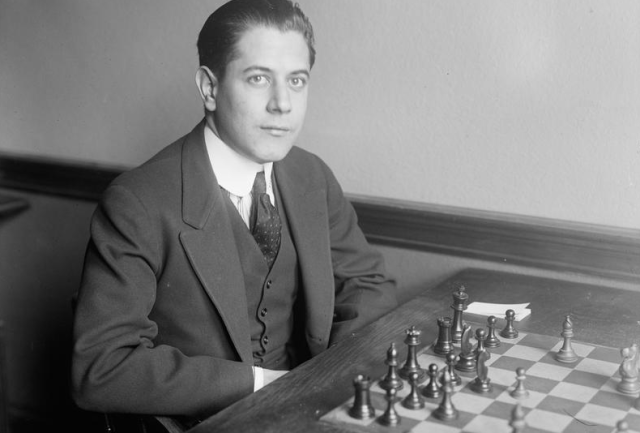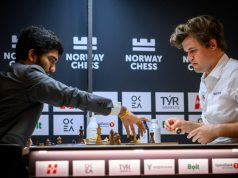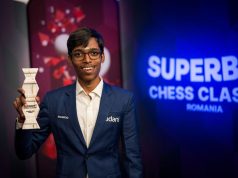In our series ‘World Champion Born On This Day,’ I wish to acquaint readers with Jose Capablanca, famously known as the Chess-Playing Machine.
Jose Capablanca never believed in studying openings. He surprised everyone with his rapid pace of moves and the one who played great moves without being able to give any strategic justification for the choice. He was called ‘The only Chess Genius’ by Dr Emanuel Lasker and ‘The most accurate Chess player after Paul Morphy’ by Bobby Fischer.
Capablanca was born in Havana, Cuba, in 1888. Two days before his 13th birthday, he became the Cuban champion and started getting invitations to strong tournaments at an early age. Over the next two decades, Capablanca had a long series of successful tournament results.
Due to Capablanca’s extraordinary tournament record, he was chosen to Challenge the world champion Dr. Emanuel Lasker, for the World Chess Crown. Dr Lasker, who held the Crown for 27 long years (1894-1921) was rightly considered one of the most difficult players to beat. However, the match between the two ‘all-time greats’, held at Havana in March–April 1921, turned out to be a one-sided affair. The challenger won four games, drew ten and lost none.
On winning the World Crown, Capablanca, who was unbeaten for over 8 years (1916 & 1924), started proclaiming to be ‘Invincible’ till he was defeated by Richard Reti in the 5th round of New York International, 1924.
Capablanca lost his Crown to the Great Alexander Alekhine in the World Championship Match in 1927. After winning the World Championship, Alekhine attributed his success to the systematic study of Capablanca’s playing style, which revealed some hidden unknown shortcomings.
Jose Capablanca had a very simple playing style. His plans were very direct, without going into deep strategy. Capablanca was extremely brilliant in all sorts of tactics, though he is known mainly for his Endgame skills.
His book Chess Fundamentals (written in 1908) is a ‘MUST LEARN’ for every serious Chess player. Capablanca’s invention ‘Caro Kann Defence’, though initially criticised as an opening which ‘takes away the best square of the Queen side Knight on the very first move’, has now become one of the most popular openings for the last three decades.
Unlike Steinitz or Alekhine, Capablanca was often unable to explain the ideas behind his moves. At times, he was ‘wisely unsure’ of the further course of the game. Capablanca believed in keeping his options open, thereby confusing the opponents and winning with superior over-the-board tactical and technical skills.
He made Chess look very simple. Capablanca’s most famous dictum, “THE BEST WAY TO WIN IS THE EASIEST WAY TO WIN”, reveals the secrets of successful Tournament Chess in a very simple language. Capablanca always followed this principle and avoided unnecessary complications which could endanger the outcome of the game.
In 1931, Capablanca withdrew from serious Chess though he made a successful comeback in 1934, with good results. However, around this period, he showed symptoms of high blood pressure which eventually cost him his life in 1942 of a brain haemorrhage.
Learn from the Champion
Today we will see a comparatively unknown game of Capablanca which was awarded the Second Brilliancy Prize as per the 100 Best Brilliancy Prize Games by Fred Reinfeld. Though not flawless, this game is reminiscent of Capablanca’s style of focusing on tactically sound play while making slow strategic progress.
Jose Capablanca – Dawid Janowski[D30]
New York Manhattan CC New York, 1918
1.d4 d5 2.Nf3 Nf6 3.c4 e6 4.Bg5 Nbd7 5.e3 c6 6.Nbd2!?
‘ Not the Most Principled move’ as the Soviet Players would put it. Certainly ‘d2’ is not the best but squares for the QN. After all, what is the Nd2 doing in front of a Pawn on ‘d5’? Certainly, should Black choose to refrain from ….dxc4, White will be compelled to prepare for a quick e3–e4 break. However, the move played prevents the Cambridge Springs defence (….Qa5) and also avoids easy simplification with ….Be7 followed by ….Ne4 as in Lasker’s defence. This forces Black to look for an alternate possibility. Knowing Janowsky’s preference for open positions, perhaps the Champion rightly expected the ‘Classical Plan’ (….dxc4) from him. However, this turned out to be a serious positional mistake as it led to the activation of WQN.
6…Be7 [6…Qa5? An Attempt to play the Cambridge Springs Defence anyway fails to simple 7.a3 Ne4 8.b4]
7.Bd3
Dawid Janowski
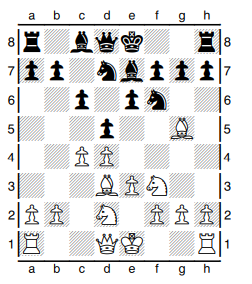
Jose Capablanca
Black has no serious problems here. There are various ways to equalise. For example,7…0–0 8.0–0 c5 Or 7…b6 8.0–0 0–0 9.Rc1 Bb7 etc. However, Black commits a strategic blunder here.
7…dxc4?!
Justifying White’s 6.Nbd2. The Knight now readily comes to ‘e5’ or even ‘d6’.
8.Nxc4 0–0
8…Bb4+?! is pointless due to 9.Ncd2. 8…Nd5?! fails to 9.Nd6+! Kf8 10.Bxe7+ Qxe7 11.Nc4 Qb4+ 12.Ncd2 Qxb2 13.0–0! with a powerful bind.
9.0–0 c5!
This is the best option here Black will still find it extremely difficult to complete his development.9…Nd5? would have led to fatal weakening of dark squares after 10.Bxe7 Qxe7 11.e4! Nf4 12.e5! c5 13.Re1 etc.
10.Rc1!
10.Qc2!? was also good but Capablanca makes his choice as per his simple style. He believed in the optimum activity of all his pieces. The move Ra1–c1 prepares for a retreat for the Bd3 at ‘b1’. The secret of Capablanca’s successful rapid & yet accurate play was his ability to avoid unnecessary awkwardness in his pieces.
10…b6
Logical.
10…b5?! fails to 11.Nce5 c4 12.Nc6!
10…cxd4 isn’t enough to equalise either. For example, 11.Nxd4 b6?? 12.Nc6 Qe8 13.Bf4! Nd5 14.Nxe7+ Nxe7 15.Be4 Nd5 16.Bd6 etc.
However, inserting 10…h6! might have been more accurate. For example, 11.Bh4 b6 12.Qe2 Bb7 13.Rfd1 b5 14.Nce5 c4 15.Bb1 Rc8 with a sharp unclear position.
11.Qe2!
White simply wants to put KR on d1 and then launch an offensive.
11.Nfe5 is pointless due to the simple 11…Bb7
11…Bb7
11…b5?! is premature due to 12.Nce5 c4 13.Bb1 Bb7 14.b3! cxb3 15.axb3 a6 16.Nc6!
12.Rfd1 Nd5?!
Black overlooks White’s brilliant idea.
12…b5!? was possible & preferable now. The game could go 13.Nce5 c4 14.Bb1 Rc8 15.b3 cxb3 16.axb3 a6 with a complex & dynamically balanced position.
Dawid Janowski
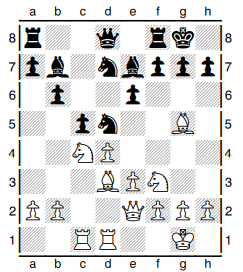
Jose Capablanca
13.Nd6!!
13.Bxe7? is pointless given 13…Qxe7 14.dxc5 Nxc5 with complete equality.
13…Bc6
Forced.13…Bxg5? loses to 14.Nxb7 Qe7 15.Nxg5 Qxg5 16.dxc5 Nxc5 17.Nxc5 bxc5 18.Rxc5 Qf6 19.Rdc1 Rab8 20.b3 etc.
13…Rb8 is bad on account of 14.Nxb7 Rxb7 15.Bxe7 Qxe7 16.a3 Rc7 17.g3! with a powerful bind.
14.Ne4!
White suddenly shifts his c4 knight to e4 from where it will target ‘c5’ while keeping a check on the K side!14.Bxe7 Qxe7 gives Black complete equality.
14…f5?!
This move is not Anti-Positional as it seems to be, because Black will be able to get ….e6–e5 by force. However, the move is tactically incorrect.
The alternative 14…Nb4!? would have led to interesting complications. The game could go 15.Bb1! Nxa2! 16.Rc4! b5 17.Rxc5! Nb4 18.Rcc1 with a big positional advantage.
However, 14…Bxg5 15.Nfxg5 h6 16.Nf3 Qe7 17.dxc5 Nxc5 18.Nxc5 bxc5 19.Ne5 Bb7 would have given a slightly inferior but tenable game.
15.Bxe7 Qxe7 16.Ned2! Setting an ingenious trap.
Dawid Janowski
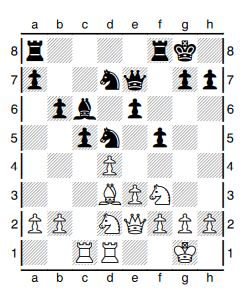
Jose Capablanca
16…e5?
Black falls in the trap! Black rids his Pawn structural weakness but is now exposed to unexpected tactical treats along the open files and diagonals.
17.dxe5 Nxe5 18.Nxe5 Qxe5 19.Nf3!
Where should Black retreat?
19…Qf6?! loses to 20.Bc4! Rad8 21.e4! fxe4 22.Qxe4 Qf5 23.Qxf5 Rxf5 24.Rd2! b5 25.Bf1 c4 26.a4 a6 27.b3! c3? 28.Rxc3
However, 19…Qe8! Protecting the ‘Bc6’ would have avoided immediate defeat, though White maintained winning advantage after 20.Bc4 Rd8 21.Rd2! Rf7 22.b4! 22…cxb4 23.Bb3! (Threatening 24. Rxc6) 23…Bb7 24.Rcd1 Rfd7 25.Ba4! and White wins, as 25…Nc3? fails to 26.Qc4+!
In the game, Black chose 19…Qe7?
Dawid Janowski
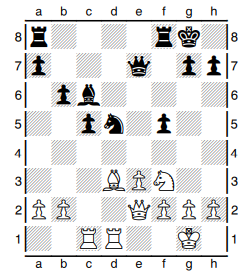
Jose Capablanca
20.Nd4!!
The decisive stroke!20.Bc4 is not so effective. 20…Rad8 21.Rd2 Kh8 22.Rcd1 Nf6 23.Rxd8 23…Rxd8 24.Rxd8+ Qxd8 25.Ne5 Be8 with a tenable position.
20…cxd4!
20…Bd7? loses to 21.Bc4 Qf7 22.Nf3!.
20…Bb7 21.Nxf5 Qf6 22.Ng3 offers no relief.
21.Rxc6 Nb4?
This loses without putting up any fight. Relatively best was 21…Rad8 though White wins with 22.Bc2!
(But not 22.Bc4?? due to 22….Qd7!)
22…f4 23.Qd3 g6 24.Bb3 fxe3 25.fxe3 Kg7 26.Qxd4+ Nf6 27.Qc3!with a winning position.
22.Bc4+ Kh8 23.Re6+– d3! 24.Rxd3! Qc5 25.Rd4! b5
Dawid Janowski

Jose Capablanca
26.Bxb5
Typical Capablanca. He refrains from the ‘objectively strongest’ choice 26.Qh5!
A possible continuation could be 26.Qh5! bxc4
(26…g6 loses to 27.Rxg6 bxc4 28.Rd7)
27.Rh4 Kg8
(27…h6? 28.Rxh6+ gxh6 29.Qxh6+ Kg8 30.Qg6#)
28.Qxh7+ Kf7 29.Qg6+ Kg8 30.Rh7! Qc7 31.Qh5! forcing mate.]
26…Nxa2 27.Bc4 Nb4 28.Qh5!
There we are! White has succeeded in getting the same position without danger to the Bishop on ‘c4’.
28…g6!
28…Rad8? allows 29.Rxd8 Rxd8 30.Re8+
28…Qc7 29.Rh4 g6 30.Rxg6 doesn’t offer any chances anyway.]
29.Rxg6 Rad8
Dawid Janowski
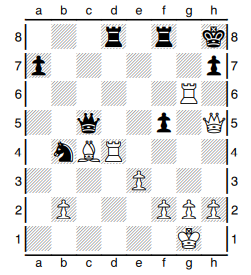
Jose Capablanca
Capablanca clinched the issue with 30.Rg7!!
Black resigned given the following variation.
30….Kxg7 31.Qg5+ Kh8 32.Rxd8 Qd6
32…Nc6 33.Qf6#
32…Rxd8 33.Qf6#
33.Qg8+! Rxg8 34.Rxg8#1–0

